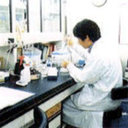Epicutaneous administration of papain induces IgE and IgG responses in a cysteine protease activity-dependent manner.
キーワード
概要
BACKGROUND
Epicutaneous sensitization to allergens is important in the pathogenesis of not only skin inflammation such as atopic dermatitis but also "atopic march" in allergic diseases such as asthma and food allergies. We here examined antibody production and skin barrier dysfunction in mice epicutaneously administered papain, a plant-derived occupational allergen belonging to the same family of cysteine proteases as mite major group 1 allergens.
METHODS
Papain and Staphylococcus aureus V8 protease were patched on the backs of hairless mice. Transepidermal water loss was measured to evaluate the skin barrier dysfunction caused by the proteases. Papain or that treated with an irreversible inhibitor specific to cysteine proteases, E64, was painted onto the ear lobes of mice of an inbred strain C57BL/6. Serum total IgE levels and papain-specific IgE and IgG antibodies were measured by ELISA.
RESULTS
Papain and V8 protease patched on the backs of hairless mice caused skin barrier dysfunction and increased serum total IgE levels, and papain induced the production of papain-specific IgG1, IgG2a, and IgG2b. Papain painted onto the ear lobes of C57BL/6 mice induced papain-specific IgE, IgG1, IgG2c, and IgG2b, whereas papain treated with E64 did not. IgG1 was the most significantly induced papain-specific IgG subclass among those measured.
CONCLUSIONS
We demonstrated that the epicutaneous administration of protease not only disrupted skin barrier function, but also induced IgE and IgG responses in a manner dependent on its protease activity. These results suggest that protease activity contained in environmental sources contributes to sensitization through an epicutaneous route.


